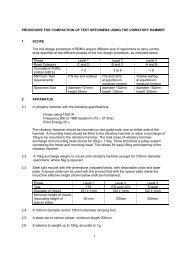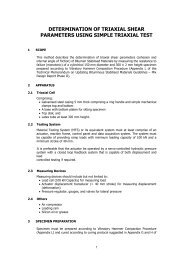Updating Bituminous Stabilized Materials Guidelines Mix Design Report Phase II
Moisture Sensitivity: Part II (Validation) - Asphalt Academy
Moisture Sensitivity: Part II (Validation) - Asphalt Academy
- No tags were found...
You also want an ePaper? Increase the reach of your titles
YUMPU automatically turns print PDFs into web optimized ePapers that Google loves.
2.2 BSMs for MMLS3 testing<br />
The intention of this study is to validate materials that known to be resistant to moisture<br />
damage and materials known to be susceptible to moisture damage. The Initial study included<br />
validation of crushed Hornfels (G2) material. In the addition study, due to time constraints,<br />
limited test were done on Hornfels (RAP) and Quartzites (G4) materials.<br />
Due to the development of a compaction procedure for BSMs to produce triaxial sized<br />
specimens, see Task 12, this procedure followed for the production of specimens for the MMLS3<br />
tests. The triaxial specimens produced, have dimensions of 300mm high and 150mm in<br />
diameter. By having specimen dimensions and an indication of the density of the material, the<br />
amount of aggregates to mix one specimen is calculated. A mass of 12kg material needed to<br />
make one specimen.<br />
2.2.1 <strong>Mix</strong>ing of the <strong>Materials</strong><br />
The initial study tested four different types of BSMs and additional study tested four different<br />
types of materials as indicated in Table J.1. Three materials on the initial study tested after<br />
accelerated laboratory curing. The fourth material selected from Hornfel-RAP with 1% cement<br />
cured for more than 9 months at room temperature. The additional study also tested specimens<br />
after accelerated laboratory curing, more tests are envisage on additional study however results<br />
of only four tested materials were available during final report writing.<br />
Table J.1: <strong>Mix</strong> type and testing Matrix<br />
Binder type<br />
A - Emulsion<br />
B- Foamed<br />
bitumen<br />
Aggregates type<br />
Initial test<br />
Additional test<br />
Crushed Hornfels (G2) Hornfels-RAP + 2% Quartzite + 2%<br />
+2% residual binder residual binder<br />
residual binder<br />
<strong>Mix</strong> 1: 0% filler <strong>Mix</strong> 1: 0% filler <strong>Mix</strong> 4: 0% filler<br />
<strong>Mix</strong> 2: 1% cement <strong>Mix</strong> 2: 1% cement<br />
<strong>Mix</strong> 3: cured more than <strong>Mix</strong> 3: 1% lime<br />
9 months<br />
<strong>Mix</strong> 4: 0% filler<br />
2.2.2 Curing<br />
The curing of the specimens is an essential component on the development of strength within<br />
the mixes before exposure to moisture. In order to carry out curing, the specimen is placed in<br />
an oven just after compaction. Initially, the specimen is placed in the oven for 20 hours<br />
unsealed at a temperature of 30ºC. Without sealing from the dry warm air, the moisture reduces<br />
9












